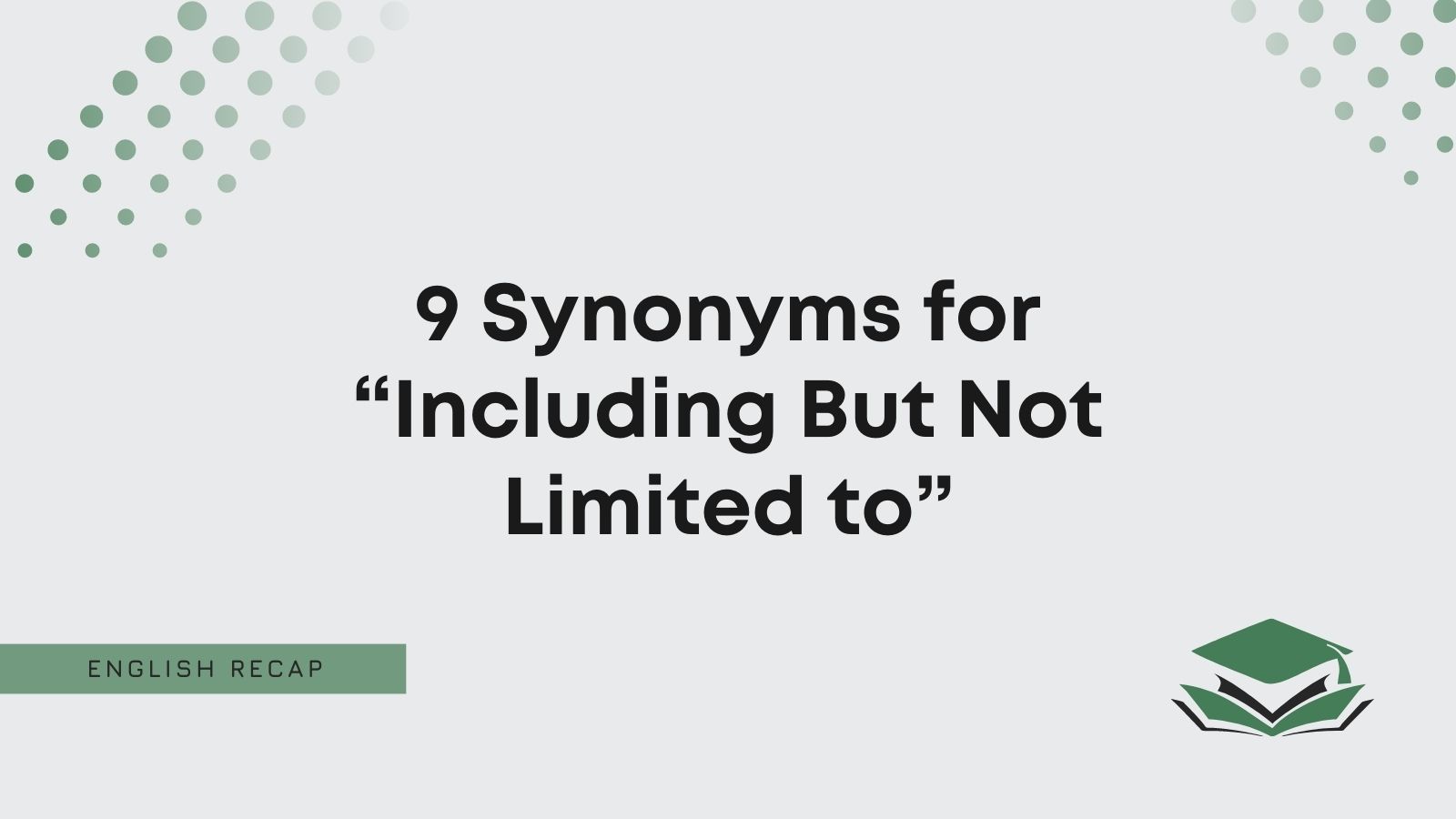You are on the hunt for a synonym for “including but not limited to” that sounds less wordy, aren’t you?
There are plenty of great alternatives available and we’ll show you exactly how they work!
Can You Say “Including But Not Limited to”?
You can say “including but not limited to,” though it is a little redundant. It might not work all that well in more formal contexts. After all, just using “including” tends to work without needing the extra “but not limited to.”
Here’s a quick example to show you how to use the phrase:
We agree with these rules, including but not limited to the one about deadlines.
Pros
- It’s a great way to highlight something specific independent from other variables.
- It’s a clear and concise phrase that most people understand.
Cons
- It’s generally redundant.
- You should avoid it formally when “including” works just as well.
To sum up, you can use “including but not limited to” but it is a redundant phrase.
So, let’s mix things up a bit, shall we? It’s always smart to change up the phrases you use to keep your writing interesting regardless of the context.
We have gathered the 9 best synonyms for “including but not limited to.” So, keep reading and select your favorites to use in your emails.
Synonyms for “Including But Not Limited to”
- Including
- Not forgetting
- Options include
- The options are
- For instance
- Could be
- In this case
- Not limited to
- Together with
1. Including
It might seem a bit obvious to remove “but not limited to,” but “including” already works really well on its own. It’s a very professional way to list something and include specific things, even though you might not include everything.
For instance, let’s say you have three options (A, B, and C). You might say the following:
- We have three options, including A.
So, you can “include” the first option, but you also make it clear that there are others without stating them. After all, you’ve used “three options” in the example, showing that it is plural and you have a choice.
Here are some examples to help you understand it better:
I’m going to run you through the changes now, including the items that you referenced previously.
We will talk more about these problems, including the ones that we thought we had already resolved.
2. Not Forgetting
Another way to say “including but not limited to” is “not forgetting.” It’s a slightly more casual way to include items from a list. However, it’s still very effective in some business cases.
You should use “not forgetting” when filling out your resume. It’s a strong way to show a potential employer that you have a long list of things to share with them (i.e., you might use “not forgetting” when trying to sell your skills).
These examples will also show you how to use it:
I can help you with a few different methods, not forgetting the ones that worked with our other colleagues.
I’m a very good candidate with many skills, not forgetting my ability to adapt under pressure.
3. Options Include
Generally, a list contains multiple options. So, something like “options include” is a great way to list a few options without listing them all. That’s why it’s a great alternative to “including but not limited to.”
Providing someone with options included in a longer list shows that you have a few questions you’d like to discuss. Then, you can make your future decisions based on the options you’ve laid out.
These examples will also help you:
Your options include looking into the system yourself or getting someone else to do it.
Why do the options include learning new skills? I thought the skills we had were enough.
4. The Options Are
Another great way to list options is with “the options are.” It’s a direct phrase that allows you to list options without using overly wordy phrases like “including but not limited to.”
Generally, this phrase works best when writing essays and listing your options. It gets straight to the point, allowing the reader to pay attention to the things you want to discuss without listing everything that might be relevant.
You can refer to these examples to help you:
The options are doing it yourself or working as part of the team. You choose.
The options are getting the correct equipment or working around the errors that will inevitably come up.
5. For Instance
Generally, “for instance” is a great way to replace “including but not limited to.” It allows you to give a few examples without going into too much detail. It keeps information clear and concise, just like when using something like “including” to list items.
You should only use “for instance” when listing one option. It doesn’t typically work when you add too many options to the list. For example:
You have a choice. For instance, taking me with you will work.
“You could take me with you” is one option. It works well after “for instance” without using “and” or “or” to list multiple points.
Perhaps these examples will help you with it:
We have a few ideas that might help. For instance, meeting with them privately first.
I can give you some options. For instance, talking to them will help you understand what they want.
6. Could Be
It’s worth using something like “could be” when you want to present options casually. It’s an ideal phrase if you’re talking to colleagues and letting them know about a few options without mentioning them all.
“Could be” isn’t a very confident phrase. The use of “could” suggests that you’re not too sure about the options yourself. That’s why it’s not a very effective phrase when used professionally.
You should refer to these examples to help you:
There are plenty of reasons behind this. It could be the server at fault, but we’re not sure about that.
Of course, the issues could be the boss’s mistakes. Or maybe there’s something else going on.
7. In This Case
If you need another synonym for “including but not limited to,” try “In this case.” It shows contextual options based on a situation.
A “case” varies from context to context. So, “in this case” implies that you have a certain list of items or information to share with someone. It’s up to the recipient of the email to decide which items are most useful to them.
You can use this when talking to friends about ideas that you think might help them. For instance, they might be writing a resume and need your help understanding their options.
Here are some examples to show you how it works:
You have a few options. In this case, turning yourself in might be the best idea.
We can help you choose. In this case, listing your skills will be more beneficial.
8. Not Limited To
“Including but not limited to” works well in itself, but it’s a bit redundant. So, why not remove “including” from the phrase? That’s where “not limited to” comes in.
You might use this one in resumes when writing things in a listed format. For instance, it could work well when sharing your skills with a potential employer.
“Not limited to” generally suggests there are more options besides the ones you’ve provided. If the recipient wants to learn about the other options, they only need to ask you.
Here are some examples to help you:
I have many skills, not limited to the ones listed above. I believe I’m the best candidate for this job.
My choices are not limited to this college, though I’m more than happy to explore my options there.
9. Together With
It’s always interesting to give someone a choice. You can do this by saying “together with” when you want to provide some options.
You might use this one when listing choices or options in contracts or resumes. It allows you to review specific options that might be relevant to the person you’re speaking to.
You can check out these examples to help you:
This contract includes many issues, together with the ones that we’ve already highlighted. We’ll certainly find more.
There are many skills here. Together with the scientific ones, I think we’ve found our candidate.

